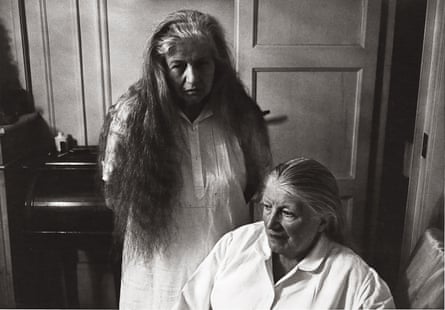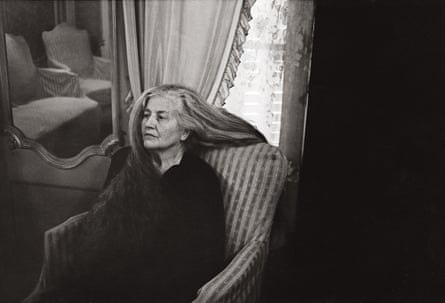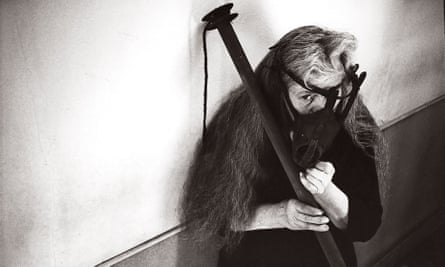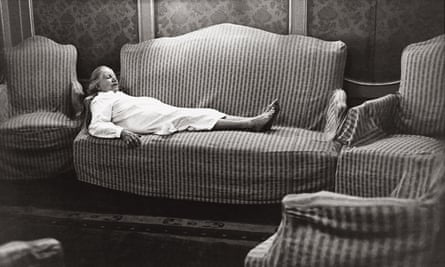In 1974, Hervé Guibert, a precocious 18-year-old fledgling artist, asked his great-aunts, Suzanne and Louise, if he could make a film about them. The pair lived a life of reclusive eccentricity in a Parisian hôtel particulier (grand urban house) in the 15th arrondissement alongside a pampered German shepherd guard dog called Whysky. Though Guibert was one of their very few regular visitors, they dismissed his suggestion outright. Undaunted, he wrote a play based on their life – it was never produced – and took hundreds of photographs of them, mostly from across the table at their regular lunches.
“Everything began to take off when I began to print some photos just to see, to show them,” he recalls in a passage from Suzanne and Louise, a roman-photo (photo novel) that first appeared in a French edition in 1980 and is about to be published for the first time in English. Surprised and flattered by what they saw, the sisters agreed to be the subjects of a more ambitious project in which Guibert required them to pose more formally and even act out vignettes that reflected their intertwined lives.
 View image in fullscreen
View image in fullscreen
In her illuminating introduction to the new edition, the New York-based artist and photographer Moyra Davey describes it as a “gothic novella in pictures, in which the artist, using subterfuge and epistolary seduction, bewitches his shrewd aunts into compliance”.
He’s always flirting with transgression, if not deploying it outright
That about nails it, but does not quite prepare the reader for the sometimes disturbing dance of words and images that captures the complex psychological dynamic of the sisters’ day-to-day existence – and Guibert’s provocative role in bringing it to light. Occasionally, Guibert refers to himself in the third person, as though acknowledging his role as a crucial, if invisible, character in the strange familial narrative. “They don’t speak to each other, except when he comes to see them, every Sunday,” he writes. “They don’t ask him a single question about his life or his work, but speak to each other across him. They perform, for him, a dramatisation of their relationship. They seduce him; they are jealous. He keeps quiet and listens. They are amazed by the interest he shows in them, flattered, amorous.”
 View image in fullscreen
View image in fullscreen
Even without Guibert’s slyly manipulative authorial presence, they are quite a pair, their claustrophobic relationship a study in control and acquiescence. “Suzanne, the older one, is the one with money,” writes Guibert in his tantalisingly scene-setting prologue. “Louise, her sister, the former Carmelite, serves as her humble, tyrannical maid. Suzanne tells tales of stinginess, of remembrance, of suffering … Louise tells tales of drunkenness, asceticism, death.” Their intertwined lives are, as Guibert puts it, “ordered by a terrible, calculated precision. Nothing must upset their routine.” Which, ironically, is exactly what he does.
Hervé Guibert is a difficult artist to pin down. Born into a middle-class family in Saint-Cloud, a suburb in the west of Paris, he worked fitfully as an actor and film-maker before becoming a columnist for the French newspaper Le Monde in the late 1970s. Alongside Suzanne and Louise, he wrote critical essays, screenplays, pamphlets and intimately autobiographical novels that are now seen as forerunners of today’s fashionable autofiction genre. My Parents gleefully relates some scandalous incidents from his family’s past and recounts in often excruciating detail his pampered upbringing. Another novel, Crazy For Vincent, traces his passionate obsession with a drug-taking skateboarder who was just 15 when they first met. His work, once considered too edgy and explicit in its depiction of his homosexuality, has garnered him a new audience among younger readers who are drawn to his shapeshifting prose that moves fluently between genres and styles.
“I think Guibert abjured traditional narrative,” says Davey. “He preferred the messiness of things not adding up, not circling back. In his diary he actually mentions privileging the ‘botched’ novel over the ‘banality’ of success.”
Guibert’s most notorious book, To the Friend Who Did Not Save My Life, features a narrator who describes his experience of being diagnosed with Aids following the death of his close friend Muzil. It became a bestseller in France partly due to the scandal that ensued when reviewers realised that the character of Muzil was based on the French philosopher Michel Foucault, with whom Guibert had had a relationship. In characteristically cavalier fashion, Guibert also revealed Foucault had died of Aids-related complications rather than cancer. Transgressively intimate and fragmentary in style, the narrative moves between humour, horror and visceral truth-telling.
 View image in fullscreen
View image in fullscreen
Suzanne and Louise is of a different order; more mischievous, but not without an undertone of moral ambiguity. At one point, he communicates clandestinely with Suzanne as if he is her suitor: “The letter I might write you could be indecent: it would be a love letter. It feels like you speak to me, and that I speak to you, that we communicate better than we do with words, through these photographs … ” Her knowing reply – “I don’t know if I should treat your letter as a prank or an exercise in style” – is almost a distillation of Guibert’s approach.
“I’d say he is being playful and provocative,” says Davey, “and seeing to what limits he can push this woman, who is 60 years his senior and born in the previous century. He’s always flirting with transgression, if not deploying it outright.”
For Davey, Suzanne and Louise is “a prized rarity” among Guibert’s many publications – “his only monograph where his full gifts as an image-maker and as a writer combine”. Among the small canon of acclaimed photo novels such as Love on the Left Bank by Ed van der Elsken and The Sweet Flypaper of Life by Roy DeCarava and Langston Hughes, Suzanne and Louise is a singularly strange and compelling object.
 View image in fullscreen
View image in fullscreen
The images move back and forth between the quietly observational and the artfully staged, from the intimate to the unsettling. In one series, made after their dog Whysky has been put down, Louise reluctantly agrees to don his leather muzzle for a photo session. “As soon as I started taking the photograph,” Guibert writes, “she concentrated intensely, her entire body changed, and she started to croon, faintly, under her breath, ‘I am the poor dog, I am the poor dog … ’”
The strange triangular drama becomes even stranger with a morbidly mischievous “simulacrum” of Suzanne’s death in which the merging of provocation and black humour becomes truly surreal. “I cover her entire body with a white blanket. Louise, barefoot, kneels at the end of the sofa. She tries to lift the corpse by gripping it by the hands, pulling it by the feet. They both laugh.”
 View image in fullscreen
View image in fullscreen
Suzanne and Louise was published the same year as Camera Lucida by Roland Barthes – another friend of Guibert’s – in which the philosopher meditates on the essential relationship between photographs and mortality. Guibert died, aged 36, in 1991, the same year that Suzanne passed away. During his final months, he recorded his daily life as he struggled with Aids, and the resulting film, La Pudeur ou l’Impudeur (Modesty and Shame), was broadcast after his death on French television. Louise died in 1998. In a copy of the book they both signed for Guibert, Suzanne wrote: “To our very dear ‘grand-nephew’ Hervé, in admiration for having pulled from our obscurity this book, which is too brilliant for our modesty.”
Suzanne and Louise by Hervé Guibert, translated by Christine Pichini, is published in the US on 19 November and the UK on 2 January by Magic Hour Press. To support The Guardian and Observer, order your copy at guardianbookshop.com. Delivery charges may apply
